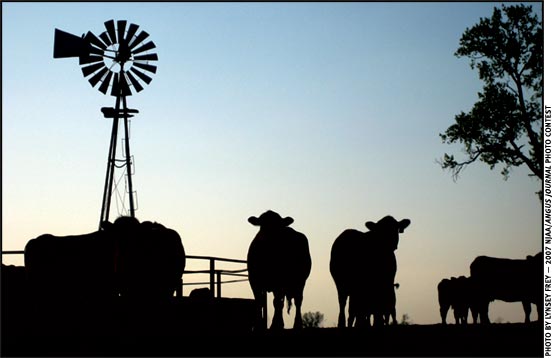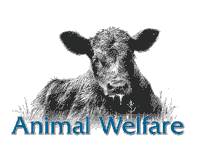
Dealing with Society's
Animal Welfare Concerns
 K-State's Glynn Tonsor provides an economist's take on animal welfare.
K-State's Glynn Tonsor provides an economist's take on animal welfare.
Consumer interest in livestock production methods is growing. To a lot of livestock producers, it probably looks like society is becoming overly meddlesome. Consumers seem to think they ought to write the rules for how animals are managed. At the very least they want to make sure animal welfare concerns are addressed.
In the last decade, eight states have adopted measures related to animal welfare, mostly through ballot initiatives. Gestation stalls used by the swine industry, veal calf crates and battery cages for laying hens have been the primary targets. Ohio stands out because of the agreement forged by the Human Society of the United States (HSUS) and certain state agricultural groups calling for numerous animal welfare "reforms," including the phasing out of those previously mentioned confinement housing systems. The agreement also addresses handling of downer animals and methods of euthanizing farm animals.
"It's naïve to think we can dramatically change that," opines Tonsor. "The disconnect probably is here to stay."
Credibility issues
Thus far, society's action in the name of animal welfare has focused primarily on swine and laying hens. Interestingly, however, survey results showed beef cattle actually ranked higher, on average, relative to consumer concern for the welfare of livestock. Tonsor says studies also show consumer concern is not limited to certain parts of the country, nor is the level of concern related to age, education or income level. People are influenced by information — not all of which is accurate — and perceptions of information accuracy depend on the source.
"Perceptions of the credibility of livestock groups versus that of consumer groups are critical drivers of (ballot initiative) voting behavior," states Tonsor.
It's no surprise, perhaps, that people likely to support animal welfare ballot initiatives typically have more confidence in consumer groups championing the cause, and less confidence in information provided by livestock groups. More surprising, however, is the evidence that scientific data supporting either side's position, or the lack thereof, may not sway voters. As an example, Tonsor cites the scientifically unfounded but still common perception that food safety and the quality of pork is reduced when gestation crates are used. Consumers also cling to the notion that food produced on small operations, rather than so-called factory farms, is somehow safer and of higher quality.
Interestingly, says Tonsor, voter support of animal welfare initiatives doesn't necessarily match consumer buying behavior. More often than not, price drives product choices. For example, most consumers still shy away from higher-priced "cage-free" eggs, for which the mean premium is 57%.
Long-term effects
Tonsor says the attention paid to animal welfare issues by the media can affect consumer food spending. One study suggests the impact of negative reports may last up to six months, influencing shifts in consumer spending during the quarter that a report is released, and the following quarter. But a report casting a negative light on one meat animal species does not result in a trade-off for meat from different species. For example, if pork production practices were the target of a specific media report, the bad publicity wouldn't necessarily mean that consumers will buy less pork and increase spending for beef and chicken. Instead, they will buy less meat of any kind.
"This is just one study — the only one of this type — and more research should be done," states Tonsor. "But the results suggest an aggregate meat demand impact exists. All meat species lose as expenditures leave the meat complex."
Of course, the nature of media is changing. Along with print and broadcast segments, computers and mobile devices provide opportunity for information to flow constantly and instantly. Tonsor believes more research is needed to assess the impact of "videos gone viral," but a 2010 study indicated videos relating positive or negative animal welfare messages can alter consumer perceptions — at least for the short term.
"I'd argue that, if seen right before entering a ballot box, a video could influence voting decisions on animal welfare-related regulations," says Tonsor. "But there is that mismatch between ballot box behavior and purchasing behavior. It creates quite a dilemma for livestock industries."
Tonsor notes the 2011 agreement between the United Egg Producers (UEP) and HSUS to seek federal legislation requiring replacement of conventional cage batteries with "enriched housing" systems for laying hens. The UEP/HSUS agreement also calls for mandatory labeling of egg cartons, informing consumers of the type of system used to produce the eggs — conventional battery cages, enriched cages, cage-free or free-range. The agreement serves as evidence of increasing discussion about national standards for animal welfare — federal legislation that would eliminate regulatory differences among states.
"There might be support for mandatory labeling, too, but there is no indication of buying support. Consumers don't want to pay higher prices to cover the added (production) costs resulting from regulations," says Tonsor. "But producers need demand impacts for required changes to make economic sense."
The UEP/HSUS agreement also shows that passing a ballot initiative is not the only way animal welfare issues are addressed. Industry organizations, processors and retailers may drive change. An important implication, says Tonsor, is that fighting ballot initiatives at all costs may not be an optimal approach for livestock producers. Change may result anyway, as a result of other pressures. It might even be market-driven.
Producer options
So what are livestock producers to do? According to Tonsor, they could do nothing — just wait and see what happens. Eventually, someone will tell them what to do. The disadvantage to this approach is having no influence in decisions affecting their businesses. It also may be perceived among consumers as indifference.
Tonsor says a different and probably better approach is to be aware of society's animal welfare concerns, think carefully and be proactive. Producers may need to act on multiple fronts, including searching for common ground by actually negotiating with animal welfare advocacy groups. Producer organizations may want to consider seeking ag-friendly legislation. That, says Tonsor, may be more productive than reacting to ballot initiatives. Thinking in terms of minimizing loss, rather than maximizing profit, livestock producers might even want to support certain voluntary labeling practices. However, Tonsor advises careful consideration of how these things might affect foreign trade.
While attempting to educate all consumers about agriculture isn't practical, Tonsor thinks livestock producers are likely to benefit from investment in their collective public image. It might help to "reconnect" with the public. Tonsor likes the Center for Food Integrity's approach, which involves all segments of food production. Together with farmers and ranchers, various universities, food processors, restaurants, retailers and food companies make a coordinated effort to provide balanced information, highlight "best practices" and build consumer trust.
"It's no short-term fix," says Tonsor, "but it may be necessary to long-term survival."

[Click here to go to the top of the page.]








